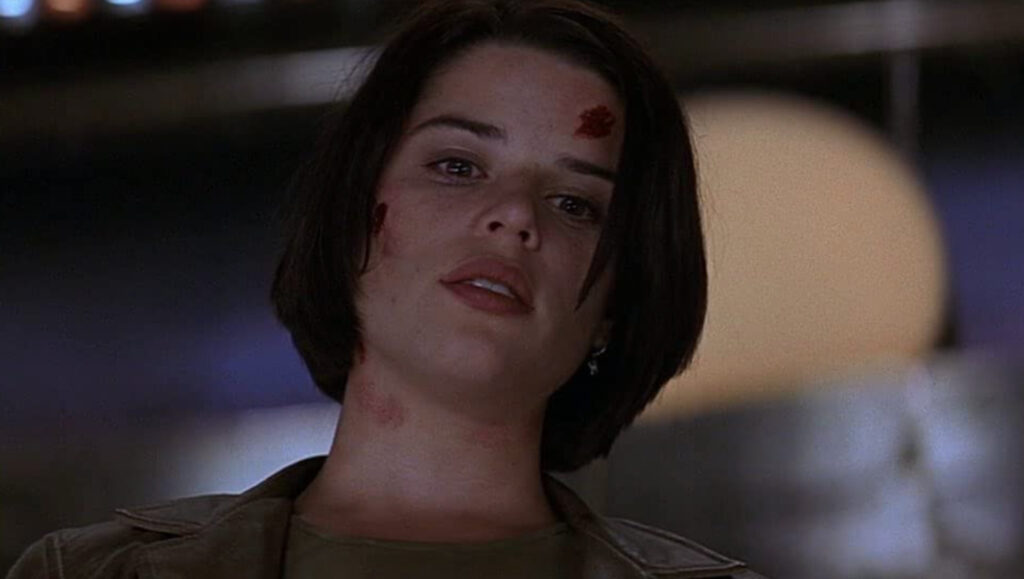Strong Female Antagonist: Scream 2, Mrs. Loomis, and the Lengths a Mother Will Go for Revenge
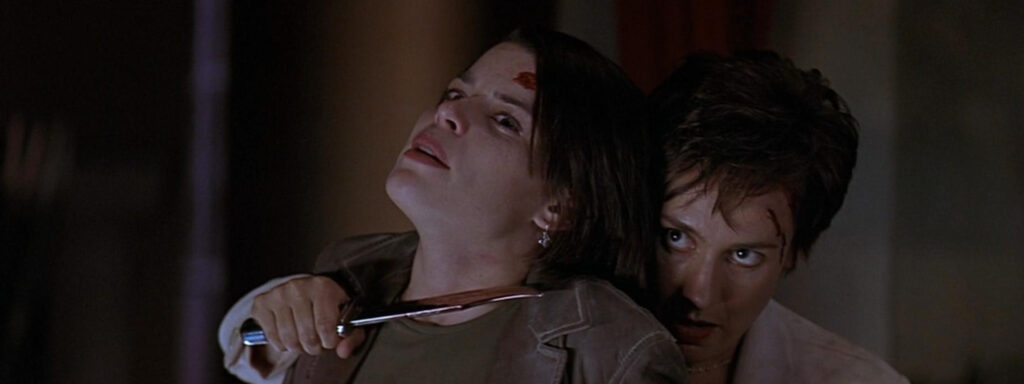
Many believe Scream 2 to be the best film of the Scream franchise if not the best sequel of all time. Released only a year after the original film, record time for a production of its size and complexity, Scream 2 cleverly builds upon themes introduced in the original without managing to feel repetitive. The near-perfect sequel also contains an anomaly in the slasher world: a female killer. Debbie Salt (Laurie Metcalf) aka Mrs. Loomis is revealed in the final act to be the second person behind the Ghostface mask and the brains behind the entire plot. As Billy (Skeet Ulrich)’s mother, her crimes build upon her son’s murderous intentions, add layers to Sidney (Neve Campbell)’s torment, and ultimately make a powerful statement about internalized misogyny among women. Mrs. Loomis continues a tradition of female villains who misplace blame and kill to support the status quo and women’s place in the patriarchy.
Her Story
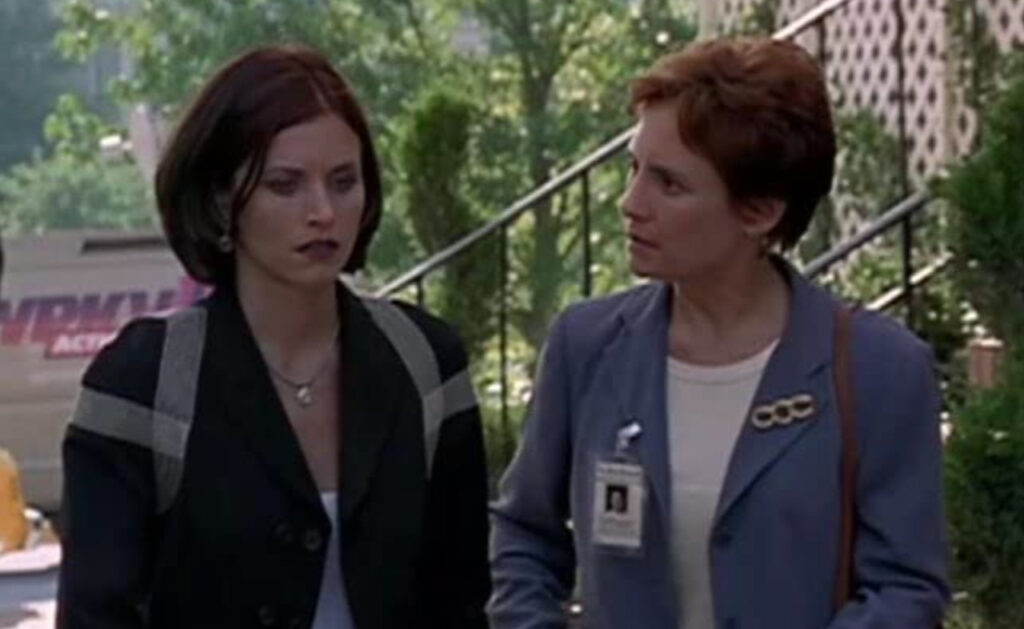
Debbie Salt is a reporter for the local paper who first appears at Windsor college after the murders of Maureen (Jada Pinkett Smith) and Phil ( Omar Epps). Investigating the story in her own right, she seems to have a professional crush or at least an unhealthy obsession with Gale Weathers (Courtney Cox). The over-eager Debbie flatters Gale with questions and tries to work her for information though she is constantly and rudely dismissed. In the film’s final act, Debbie is revealed to be the second killer financially supporting the more fanatical Mickey (Timothy Olyphant). We also learn that Debbie Salt is an alias. Her real name is Mrs. Loomis and she’s the mother of Scream’s first killer and Sidney’s former boyfriend, Billy. Before the events of the first film, Mrs. Loomis discovered that Sidney’s mother Maureen had been having an affair with her husband. She responded by leaving town and abandoning her son Billy, inadvertently setting into motion the acts of the entire franchise.
Her Victim

Though Mrs. Loomis is only feigning her admiration for Gale and likely does not care for the assertive reporter, her attention seems mostly fixated on Sidney. Mrs. Loomis holds Gale hostage and brings her to Sidney in the film’s final showdown, essentially dismissing her and leaving her for dead once Gale falls into the orchestra pit. She blames Sidney for the ruin of her family and for the death of her son, though it’s clearly not Sidney’s fault. She has always been an innocent bystander, caught up in the swells of chaos around used as a focal point for the pain of others. Sidney did kill Billy, but only in self-defense and only after he’d murdered her friends and family.
In fact, Gale is arguably more responsible for Billy’s death and subsequent vilification. Gale is the one who first shoots and incapacitates Billy before he can stab Sidney. Gale is the one who twice foils his master plans in the film’s climactic scene. Gale is the one who wrote a book about her son, portraying him as a cold-blooded killer and launching a film franchise about his crimes. Yet Mrs. Loomis chooses Sidney as the focus of her revenge.
She likely sees Sidney as a representation of her mother Maureen, the woman she believes is responsible for ruining her marriage. In that regard, she has every right to be angry. The infidelity of one’s partner can be extremely painful, but shouldn’t some of that anger be reserved for her own husband? He is the one who actually broke the vows he made to her. As we find out in Scream 3, Maureen’s promiscuity is likely the response of trauma from a brutal assault she suffered in Hollywood. Not to excuse her affair with a married man, but it’s doubtful that Maureen set out to specifically destroy Mrs. Loomis’s family. Her rage is a reflection of the patriarchal premise that women are foul temptresses and men are helpless to resist their charms. Why blame her own husband when she can blame the other woman? Why examine her part in the downfall of her marriage when she can lay the blame at the feet of a “homewrecker?”
With Maureen dead, Sidney is the next logical scapegoat. Though she had nothing to do with the affair or Billy’s crimes, she’s a woman tangentially involved in the drama. and surely responsible in some way. Perhaps Mrs. Loomis’s fury is misplaced anger at the man who betrayed her. Or maybe she’s actually angry at herself for leaving her marriage and abandoning her son instead of attempting to work things out with her husband or arranging a co-parenting situation. Reeling from the destruction of her life, Mrs. Loomis settles her rage on the person who has caused her the least amount of harm.
Her Weapon
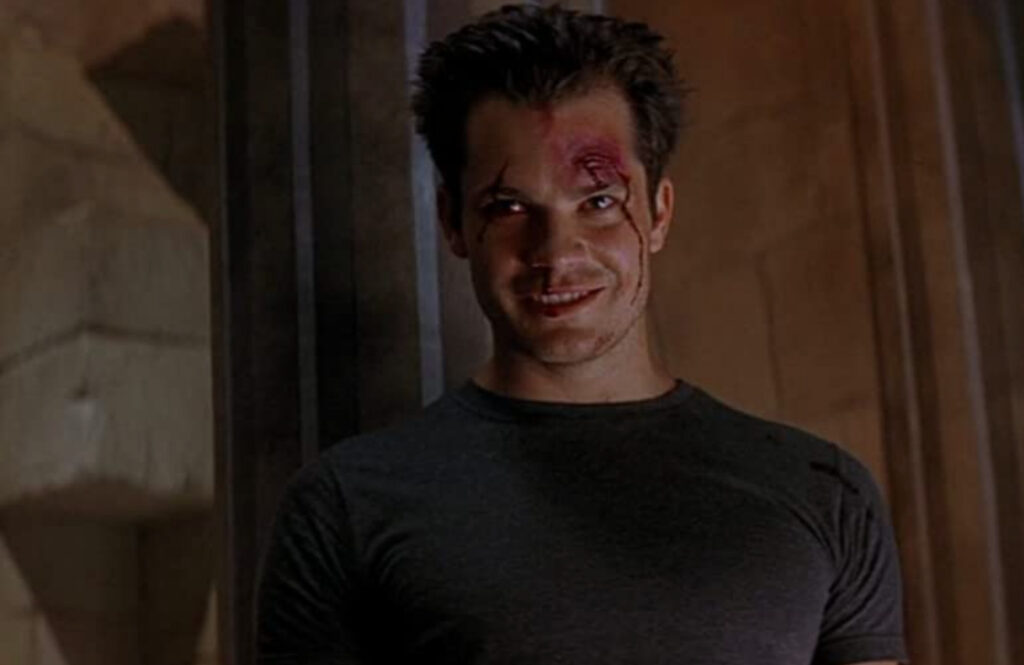
Modeling her son’s crimes, Mrs. Loomis dons the ghostface costume and wields the same type of large kitchen knife Billy and Stu (Matthew Lillard) used to murder their classmates and friends. But this choice is likely just to uphold the allusion of a copycat crime. At the end of the film, she uses a gun, having abandoned the mysterious killer’s disguise and MO once her plan has been discovered. While most of her murders are carefully planned, she looses control when killing Randy (Jamie Kennedy). Becoming enraged when he mocks her son, Mrs. Loomis takes vicious revenge with the weapon she has handy and eviscerates him in Gale’s news van.
Mrs. Loomis also uses disguises to her benefit. Hiding in plain sight, she navigates the entire film under the noses of people who should recognize her as Billy’s mother. An occasional bone of contention with the film’s plot is the fact that she has so many interactions with Gale, an investigative reporter who’s seen her picture many times and wrote a book about her son. Perhaps Gale is so blinded by Debbie’s flattery, that she loses the ability to see her professional rival objectively. Gale never recognizes Mrs. Loomis, but Sidney does immediately, quipping that her altered appearance is the result of “60lbs and a lot of work later.” The dig is a rude and judgemental comment perhaps revealing why Mrs. Loomis has been so easily dismissed in the first place. In the original film’s infamous line, “your mother was no Sharon Stone” Stu implies that Sidney’s mother wasn’t attractive enough to be promiscuous. If this is how he describes the woman who tempted Mr. Loomis away, how would he describe Mrs. Loomis? Is this the environment Debbie was seeking to escape when she left her cheating husband? A community where being overweight relegated her to second class status, barely registering on our character’s radar at all? No wonder she’s so angry.
Mrs. Loomis’s greatest weapon is Mickey himself, her partner in crime. She sought him out hoping to convince someone to do the heavy lifting in her elaborate plan. Mikey is all in, nursing his preposterous agenda to get caught and survive what will surely be a world famous trial. He’s fully invested in this plan, believing Mrs. Loomis will bankroll his defense. But he is betrayed by his surrogate mother. She kills him in the climactic showdown, revealing her hidden plan to set him up as the sole killer. This deception feels especially harsh coming from a mother, but something we would readily accept from a male killer. Debbie isn’t seeking to replace her son with another questionably haired young murderer and doesn’t seem to care that he may also have a mother who loves him. Her sole purpose is to avenge her son. Mickey is just another tool at her disposal.
Her Motive

Mrs. Loomis’s motive is revenge. She wants Sidney to pay for murdering her son. Blinded by her love for him and a patriarchal idea that any mistakes committed by a man are surely the fault of a woman, she sees Billy as an innocent victim. He is not the mastermind behind the Woodsboro Murders, but a poor boy who’s world was destroyed by a homewrecker and her cruel daughter. She can’t see that Billy’s choices led him to kill. He may have been influenced by the tragedies in his life, but as Sidney notes in Scream 3, he murders people because he chooses to. Unwilling to blame her son for anything, Mrs. Loomis transfers all of the responsibility onto Sidney, the innocent victim.
But after all her talk of avenging Billy, is it possible she’s a little frustrated with him as well? While explaining her motive to Sidney, she mentions being sick to death of everyone blaming their parents for their own actions. Stu takes some fraction of responsibility for his crimes shortly before his death, hilariously weeping that, “my mom and dad are gonna be so mad at me!” He doesn’t fault his parents for his actions, he fears their response. On the other hand, Billy directly blames Mrs. Loomis and Maureen. While it’s scarier if he has no motive, in reality, he’s little more than another man punishing the women in his life for his own pain. Unwilling to shoulder the guilt of her son’s crimes, Mrs. Loomis continues this transference and heaps the responsibility on Sidney.
Her Legacy
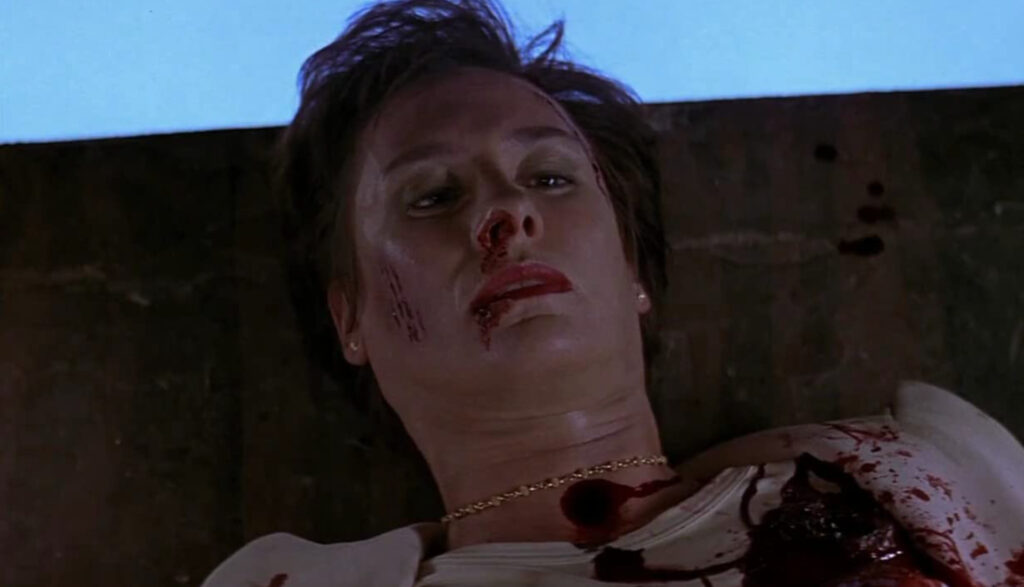
The film’s climax is both exciting and poignant. On the set of her college play, Sidney uses facsimiles of a storm to disorient Mrs. Loomis, defending herself with the power of her own trauma. After watching yet another loved one die, she enacts the thunderstorm Billy created for her life. Mrs. Loomis wasn’t there to face Billy’s wrath. Sidney and her mother were forced to bear the turmoil of his anger alone and have both paid dearly. Sidney recreates this storm for Mrs. Loomis, showing her what it truly feels like to have your world crumble around you.
In the end, it’s Cotton (Liev Schreiber) who actually shoots Mrs. Loomis. Holding Sidney hostage, she tries to negotiate with Cotton, another victim of her son’s crimes. Mrs. Loomis attempts to persuade the wrongfully accused man to kill Sidney as punishment for sending him to prison. The bitter irony is that Sidney regrets misidentifying Cotton as her mother’s killer, a decision largely rooted in the trauma of finding Maureen’s murdered body. Billy intentionally framed Cotton for the crime and would have willingly sent him to prison for the rest of his life if not for Gale and Sidney who found the real killer. Her desperate manipulation is another example of Mrs. Loomis blaming a woman for the actions of a man.
Scream 2 is a rich text in feminist horror, with many strong and complex women to discuss. The irony inherent in Mrs. Loomis character is that she targets any woman she can find before placing any kind of blame upon a man, perfectly exemplifying the negative effects of internalized patriarchy. Perhaps the real reason Sidney inspires so much hatred from Mrs. Loomis is that she refuses to accept responsibility for anyone’s actions but her own. She did not cause her mother’s affair. She did not cause Mrs. Loomis to leave. She did not cause Billy to kill and she will not be blamed for any of it. Sidney fights back against the people who would punish her for the misery they’ve caused for themselves. By contrast, Mrs. Loomis fights to preserve a system where women are wives, sluts, or victims and men can do no wrong.
Jenn Adams is a film critic and podcaster from Nashville, TN.
